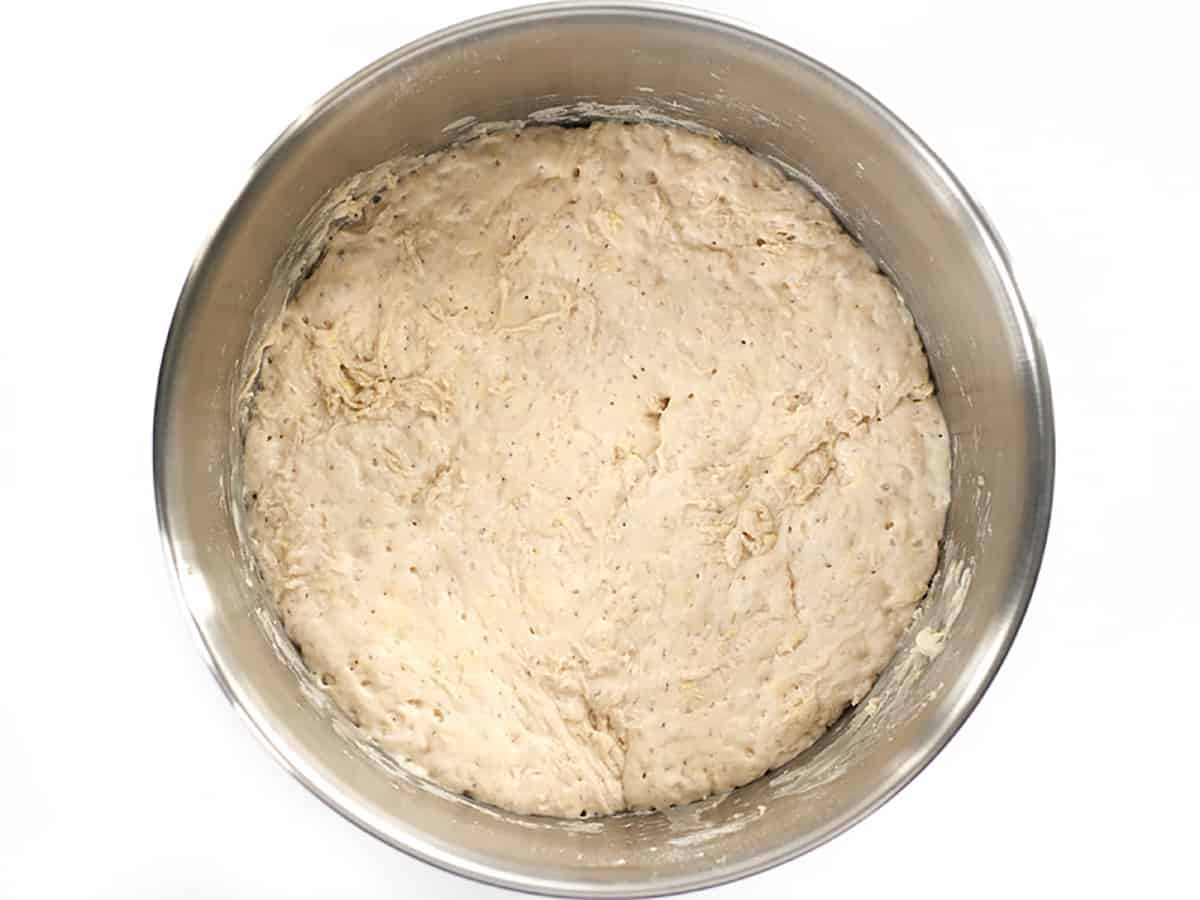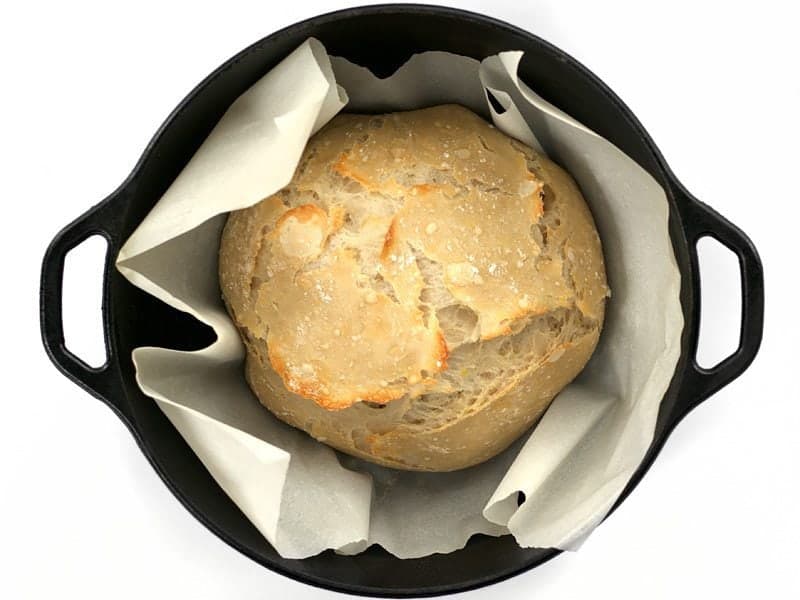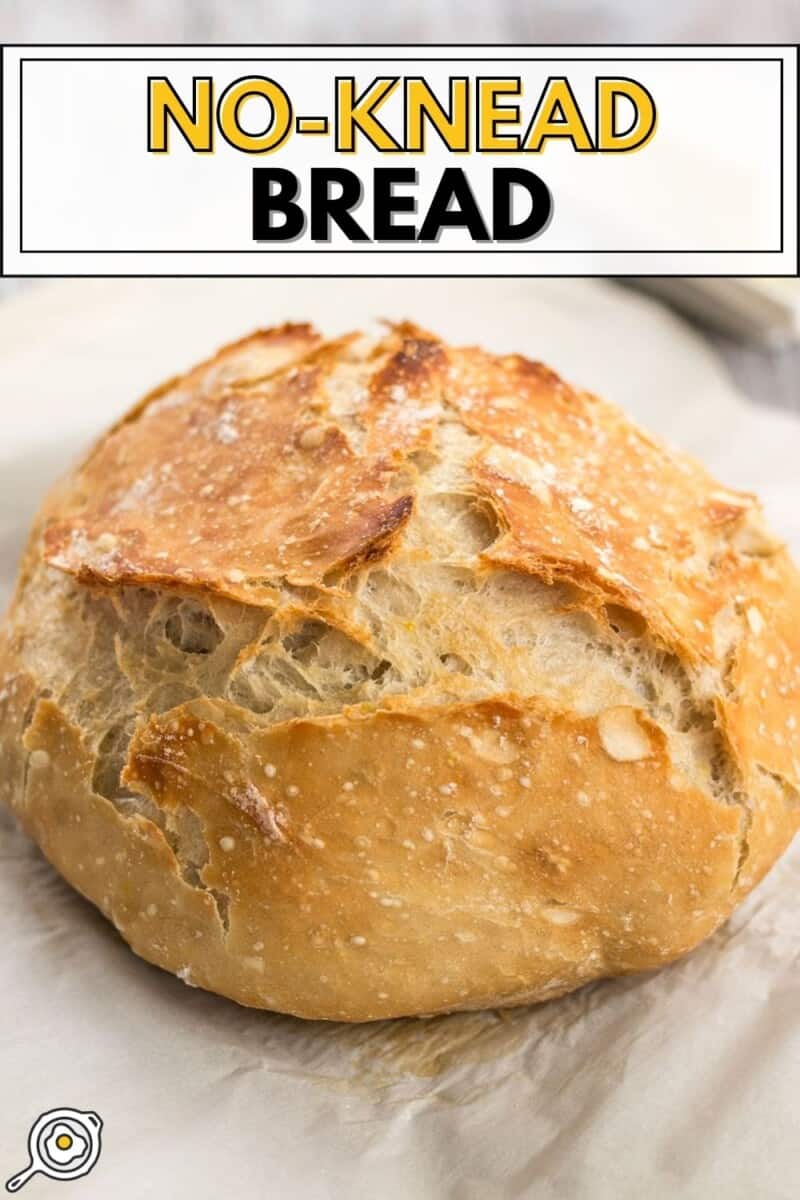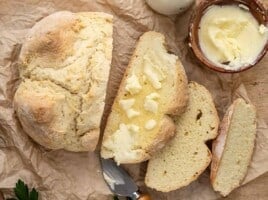I started making no-knead bread in 2010 and it has continued to be my favorite way to make homemade bread because it’s incredibly simple, it doesn’t require a lot of effort, and it makes the most deliciously crusty bakery-style bread ever. To make this no-knead bread recipe you only need four ingredients (including water) and a little bit of time. No fancy equipment or techniques needed!

This post contains some affiliate links, which means that we make a small commission off items you purchase at no additional cost to you.
“I’ve made this twice and it was amazing! Hard to believe something so simple can come together to be something so amazing!”
-Melissa
What Is No Knead Bread?
No-knead bread is an ancient technique for making delicious loaves of bread by utilizing a long fermentation time to develop the gluten the flour instead of hand kneading. Gluten is the protein that gives bread its strength, allowing it to rise into a fluffy loaf, and have that deliciously chewy texture. Kneading bread dough develops gluten quickly, but is quite labor-intensive. If given enough time, yeast can develop the gluten in the dough without the need for manual needing.
Ingredients for No Knead Bread
The best part about this no-knead bread recipe is that it only requires four ingredients, including water, and you still get an incredibly flavorful bread. Here’s all you’ll need to make your own homemade no-knead bread:
- Flour: Our version of no-knead bread was developed using all-purpose flour because that is what we most commonly have on hand. That being said, using bread flour will create even better results. Just keep in mind that bread flour tends to absorb more water than all-purpose flour, so you may need to adjust the ratios slightly.
- Yeast: For this type of bread, we use instant yeast or bread machine yeast, both of which do not need to be activated first by proofing in warm water. You can simply add them to your dry ingredients and go!
- Salt: Without the proper amount of salt, homemade bread will have no flavor, so it’s imperative that you do not skip the salt.
- Water: Water hydrates the flour to create the dough. Because this technique uses a longer ferment time, you can use room-temperature water and you do not have to “wake up” the yeast with warm water. The yeast will have plenty of time to activate as it rests.
What Kind of Yeast to Use
It’s very important to use the correct type of yeast for this recipe. Instant yeast and bread machine yeast are special because they do not require mixing with warm water to “wake up” before adding to a recipe. You can simply stir them into the dry ingredients and they will activate instantly upon hydration, so that is what we use for this super simple no-knead bread technique. Active Dry yeast, on the other hand, needs to be specifically activated in warm water first. If you use active dry yeast in this recipe using the technique below, the bread will likely not rise.
Do I Need to Use a Dutch Oven?
Using a preheated Dutch oven does create the best results because it gives the bread an extra intense boost of heat while retaining all of the moisture and steam. That being said, I have made no-knead bread on a sheet pan with great results! I suggest adding a pan with an inch or so of water on the bottom rack of your oven to create steam if you’re baking your bread on a sheet pan.
If possible, I would suggest investing in a Dutch Oven because they are easily one of the most flexible and useful pieces of cookware. We love our Amazon Basics 6-Quart Enameled Dutch Oven as a very affordable alternative to Le Creuset. Lodge also makes very affordable Enameled Dutch Ovens and plain Cast Iron Dutch Ovens (like the one used in the photos here).
Short Fermentation vs. Long Fermentation
You can make no-knead bread using either a long fermentation (12-18 hours) or a short fermentation (about 2 hours). The difference is that you’ll need more yeast to do the short fermentation and the flavor does not develop quite as deeply. That being said, short fermentation no-knead bread is a great option when you haven’t planned ahead!
Long Fermenation: Follow the instructions below, using ¼ tsp yeast and fermenting the dough for 12-18 hours.
Short Fermentation: Use 2 tsp yeast (or one ¼ oz. packet) and ferment the dough for about 2 hours at room temperature.

No-Knead Bread

Ingredients
- 3 cups all-purpose flour ($0.29)
- 1/4 tsp instant yeast or bread machine yeast* ($0.02)
- 1.5 tsp salt ($0.02)
- 1.5 to 1.75 cup water** ($0.00)
Instructions
- The day before baking, combine the flour, yeast, and salt in a large bowl and stir until they're well combined. Stir in about 1.5 to 1.75 cups room temperature water until a shaggy, sticky ball of dough forms and there is no dry flour left on the bottom of the bowl. The dough should be wet and sticky, but not so wet that it appears glossy. Cover the bowl loosely with plastic and let it sit at room temperature for 12-18 hours.
- The next day, the dough should be fluffy and very bubbly. When you're ready to bake, sprinkle a little flour on top of the fermented dough and scrape it out of the bowl. With well-floured hands, shape the dough into a ball and place it on a piece of parchment paper. Let the dough rise for 30-60 minutes.
- While the dough is rising, preheat the oven to 425ºF, or the highest recommended temperature listed on the packaging for your parchment paper. Place the Dutch oven inside the oven as it preheats, and make sure it sits in the fully heated oven for at least 15 minutes before baking the bread.
- Once the bread has risen and the Dutch oven is fully heated, carefully remove the Dutch oven from the oven (it will be EXTREMELY hot). Lift the parchment with the dough straight into the dutch oven and cover it with the lid.
- Return the Dutch oven to the oven and bake for 30 minutes. Carefully remove the lid and bake for another 15-20 minutes, or until the crust is a deep golden brown. Remove the Dutch oven from the oven, lift the bread out by by using the parchment paper, and allow it to cool before cutting open and serving.
Sheet Pan Instructions
- Ferment and shape the dough as described above, then place it on a parchment-lined sheet pan to rise for an additional 30 minutes.
- Place a baking pan with about an inch of water on the bottom rack of the oven, then preheat to 425ºF while the dough rises.
- Once the loaf has risen for 30 minutes and the oven is fully preheated, carefully score the top of the dough with a sharp knife (use horizontal motions with no downward pressure). Transfer the sheet pan to the oven and bake for 40 minutes, or until the crust is deeply golden brown and the loaf sounds hollow when tapped.
See how we calculate recipe costs here.
Equipment
- Cast Iron Dutch Oven
- Mixing Bowls
- Parchment Paper
- Liquid Measuring Cup
Notes
Nutrition

How to Make No-Knead Bread – Step by Step Photos

Before you begin, make sure you have “instant yeast” or “bread machine yeast” rather than “active dry”. The reason you need this type of yeast specifically is because it does not need to be kick-started by mixing with warm water first. You can add it to a recipe dry and it will still activate. I buy these little jars, which I keep in my fridge, and they last for-ev-er (especially when you’re only using 1/4 tsp at a time)!

The day before you want to actually bake the bread, combine 3 cups all-purpose flour, 1/4 tsp instant or bread machine yeast, and 1/2 Tbsp salt in a large bowl. Stir them together really well.

Stir in about 1.5 to 1.75 cups of room temperature water, or just enough to form a shaggy ball of slightly sticky dough, and no dry flour is left on the bottom of the bowl. The total amount of water needed may vary from time to time depending on the ambient humidity and moisture content of the flour, so go on visuals here. Make sure it comes together in one ball and no dry flour is left on the bottom of the bowl. It’s okay for it to be a bit sticky.

Loosely cover the bowl with plastic and let the dough ferment at room temperature for 12-18 hours. If you need to let it sit longer than that to fit your schedule, just transfer it to the refrigerator. As the dough ferments, it becomes very big, light, fluffy, and bubbly.

Sprinkle a little flour onto the dough (because it will be sticky) and scrape it out of the bowl. It will begin to deflate as you scrape it out.

Using floured hands, shape the dough into a ball, then place it on a large piece of parchment. Let the dough rise for 30-60 minutes. The shorter rise time will produce a slightly more dense bread and the longer rise time will have larger bubbles.

While the dough is rising, begin to preheat the oven and the Dutch oven. Set the oven to 425ºF, or whatever the highest safest temperature is for your brand of parchment (it will usually be listed on the box somewhere). Make sure your Dutch oven is inside the oven as it preheats, and then let it heat for an additional 15 minutes or so once the oven is up to temperature. This makes sure that the Dutch oven is nice and hot.

When the dough is risen and the Dutch oven is fully preheated, carefully remove the Dutch oven from the oven (it will be extremely hot!). Lift the risen dough by the parchment and place it inside the Dutch oven, parchment and all. Place the lid on the Dutch oven and return it to the hot oven.

Let it bake for 30 minutes with the lid on the Dutch Oven, then carefully remove the lid…

Then bake it for an additional 15 minutes or so WITHOUT the lid to allow the crust to brown.

Once the crust achieves a nice deep golden brown color, carefully remove the Dutch Oven from the oven. Lift the no-knead bread out of the Dutch oven by the parchment, and allow it to cool before serving.

And just be prepared for the BEST bread you’ve ever made yourself. ;) The crust on this no-knead bread is seriously amazing.
No Dutch Oven and Short Fermentation Instructions
So, as I mentioned before, you can still bake this bread without a Dutch oven and with a short, 2-hour fermentation time. Here is a photo of my no-knead bread using just 2 hours of fermentation (plus another 1 hr rise time) and baked on a baking sheet.

If you only have about 2-3 hours to ferment the dough, you’ll need to increase the amount of yeast used to 2 tsp (instead of 1/4 tsp).
Let the dough ferment in the bowl for 2 hours, then shape it into a loaf, transfer it to a baking sheet covered with parchment (and sprinkled with cornmeal, if desired) and let rise for about another hour. I like to make slits in the top with a sharp knife after the loaf has risen. Be careful though, if the knife is not sharp enough or you use too much downward pressure, it can deflate the dough.
Brush the surface of the dough with water, then bake it in a preheated oven (again, as hot as the parchment will allow, usually around 425ºF) for 30-40 minutes, or until the crust is nicely browned.







I just use more water, skip the floured board part. Dump into a pre heated, buttered, cast iron skillet. Bake immediately with a pan of hot water in it. Ultimately the only thing that needs washing is one bowl and one rubber spatula.
What if I want to use my starter instead of yeast. How much would I add?
Hi Ronni, I’m just learning how to make sourdough starter myself, so unfortunately I haven’t gotten to make any bread with the starter yet and can’t offer advice on that at this time.
I believe it is 1/4 cup starter.
Hi! My parchment paper can only be used up to 400 degrees – should I bake it longer if I need to use a lower temperature? Thanks in advance!
You could be okay Emily, my parchment says that too, but I still use it :|
Have you tried this with any wheat free flours?
Unfortunately I haven’t tried that, but I do know that the gluten in the flour is critical to creating the texture in this bread, so I’m guessing it wouldn’t work so well.
I have a 3qt Dutch oven, should I attempt to cut down recipe or do you think I should just try it?
Thank you in advance, I’m excited to try this method. I’ve used a bread machine in the past because I’m afraid of not kneading properly.
You could make two smaller loaves if you wanted to but the 3 quart could be okay!
Going to attempt this today, since we’re all stuck in our homes for an indefinite amount of time. Have you been successful making this recipe with wheat flour?
I wouldn’t suggest using more than 50% whole wheat flour because at that point it starts to affect the texture and density too much. You may need slightly more water if using some whole wheat flour as well, since whole wheat flour absorbs more than white flour.
I’m out of parchment paper and avoiding grocery stores because of the pandemic. Would lining the Dutch oven with foil be ok?
I wouldn’t suggest foil. I would simply flour the bottom of the loaf or put some cornmeal down. You’ll be okay! Just take extra care in getting it out with mitts on.
I’ve made a similar bread and just sprayed the dutch oven (after preheating it) with non-stick spray and sprinkled a little cornmeal and it came out great! No need for parchment if you don’t have it.
Hi! What to do if I can’t preheat my dutch oven/baking dish?
Thanks!
You can try using the baking sheet method outlined above :)
Thoughts on using this in the breadmaker? :)
Unfortunately I’ve never used a bread machine, so I can’t give guidance on that.
Has anyone tried this recipe or any similar using a piece of dough from the last loaf made as a replacement for the yeast. I keep reading vague references to this alternative to using fresh yeast each time, but no definitive instructions.
I might have to just suck it and see.
My dough is all wet and goopy. It keeps on sticking and when I add flour it just does not work. What does this mean?
Unfortunately I don’t think I have quite enough information to help troubleshoot this. I’m not sure which step in the process you are experiencing the issue (just after mixing? After fermentation?) and it can be hard to guess what might be the problem without actually seeing the dough myself. Sometimes words can’t accurately describe what’s going on. I have a video of me working with this same type of dough in my No Knead Focaccia Rolls blog post, if you want to see the texture of the dough in video form, and see how I work with it.
I thought I had this same problem, as my dough was really runny and I couldn’t really shape it. However, I tried baking it anyway and it came out as a pretty decent loaf! Might be worth seeing what comes out anyway as it might surprise you.
Can I use active dry yeast instead of instant yeast for this?
Active dry yeast does not activate unless it’s proofed in warm water first, so it won’t work with this particular method. You would need to adjust the method of the recipe and unfortunately I haven’t tested that variation.
I accidentally used active yeast without knowing and it turned out great. I didn’t put it in hot water first. Whoops! But I’ve made it before with instant and it tasted the same.
Can this bread be made with Gluten Free flour ?
I make a French loaf with GF flour / all purpose – either Bob’s Red Mill or King Arthur.
Unfortunately I haven’t tried that, but I do know that the gluten in the flour is critical to creating the texture in this bread, so I’m guessing it wouldn’t work so well.
Do I need a lid if I’m using a cast iron frying pan? Or just a baking sheet? Thank you!
Hi! Thank you for your great recipes :) I let my first batch of dough ferment for 18 hours, then my dog jumped up on the second rise and pulled it to the ground lol so I’m on my second batch and it’s risen for about 13 hours. I took it out of the bowl and it is VERY jiggly, like I couldn’t shape it into a ball, it just spread out into a large flat circle. I’m letting it rise again for the second time before I bake – but what should I do different next time if this happens after the fermentation period? Thank you!
Yes give it a little more time, sometimes it needs a little extra time! Also could be temperature in your home if it’s in a drafty area it can take a little longer.
How about using a cast iron frying pan instead of a baking sheet?
That could work wonderfully!
If using a cast iron skillet instead of a Dutch oven, what would you suggest as a “lid”?… foil? Also, do my cast iron skillet isn’t as deep as a Dutch oven, so I’m wondering if this bread would “overflow” in it? I’ve also occasionally used my all-clad stainless steel larger pot & lid to make roasts in, so I’ve thought of doing that, but the temperature on a roast is typically much lower than what this recipe calls for, so I’d have to see if my all-clad is safe for the 425 temp.
I just made the dough and will be baking it tomorrow! I’m excited to see & taste the finished product :)
Yes you can use foil as a lid, or just try the baking sheet method as Beth has outlined above :)